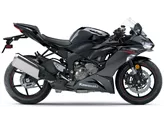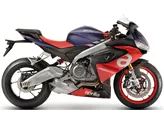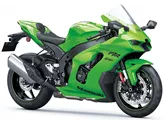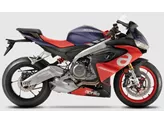Kawasaki Ninja ZX-10R 2016 vs. Kawasaki Ninja ZX-6R 2019

Kawasaki Ninja ZX-10R 2016

Kawasaki Ninja ZX-6R 2019
Overview - Kawasaki Ninja ZX-10R 2016 vs Kawasaki Ninja ZX-6R 2019
The Kawasaki Ninja ZX-10R model year 2016 and the Kawasaki Ninja ZX-6R model year 2019 are both supersport motorcycles from Kawasaki.
The Ninja ZX-10R 2016 is powered by a 998cc inline-four engine, producing 200.1 horsepower and 114.3 Nm of torque. It has a compression ratio of 13 and features a 4-cylinder configuration. On the other hand, the Ninja ZX-6R 2019 is equipped with a smaller 636cc inline-four engine, generating 130 horsepower and 70.8 Nm of torque. It has a slightly lower compression ratio of 12.9 and also features a 4-cylinder configuration.
In terms of suspension, both models have a telescopic fork at the front and a swingarm with a monoshock at the rear. The suspension on both bikes can be adjusted for compression, preload, and rebound. The suspension material used is aluminum, which helps in reducing weight and improving performance.
Both motorcycles have an aluminum frame, which provides excellent chassis geometry and contributes to overall stability and handling. The Ninja ZX-10R 2016 weighs 198 kg, while the Ninja ZX-6R 2019 weighs slightly less at 196 kg.

Kawasaki Ninja ZX-10R 2016
In terms of braking, both models are equipped with dual disc brakes at the front. The Ninja ZX-10R 2016 features radial and petal technology for its front brakes, while the Ninja ZX-6R 2019 has radial technology.
When it comes to tire dimensions, both motorcycles have a front tire width of 120 mm and a rear tire width of 17 inches. However, the Ninja ZX-10R 2016 has a wider rear tire at 190 mm compared to the Ninja ZX-6R 2019, which has a rear tire width of 180 mm.
The Ninja ZX-10R 2016 has a wheelbase of 1415 mm, while the Ninja ZX-6R 2019 has a slightly shorter wheelbase of 1400 mm. The seat height of the Ninja ZX-10R 2016 is 813 mm, while the Ninja ZX-6R 2019 has a slightly taller seat height of 830 mm.

Kawasaki Ninja ZX-6R 2019
Both motorcycles have a fuel tank capacity of 17 liters, allowing for longer rides without frequent refueling.
In terms of strengths, the Ninja ZX-10R 2016 is praised for its excellent chassis geometry, high-quality chassis components, excellent brakes, and a wide range of electronic features. On the other hand, the Ninja ZX-6R 2019 is commended for its powerful engine with a good mix of revs and torque, lively handling, and a decent and adjustable chassis.
As for weaknesses, the Ninja ZX-10R 2016 is criticized for its less than perfect legibility of the cockpit. The Ninja ZX-6R 2019, on the other hand, is said to have some details that could be more delicate, such as the license plate holder and turn signals, and its overall silhouette is not considered sporty enough.
In conclusion, both the Kawasaki Ninja ZX-10R 2016 and the Kawasaki Ninja ZX-6R 2019 are impressive supersport motorcycles with their own strengths and weaknesses. The Ninja ZX-10R 2016 offers more power and advanced electronic features, while the Ninja ZX-6R 2019 provides a lively and enjoyable riding experience with its powerful engine and adjustable chassis.
Technical Specifications Kawasaki Ninja ZX-10R 2016 compared to Kawasaki Ninja ZX-6R 2019
Pros and Cons in comparison
Pros and Cons in comparison
Kawasaki Ninja ZX-10R 2016

A ZX-10R Ninja tem uma certa majestade, ao primeiro arranque parece muito estável, é preciso forçá-la um pouco no raio. Após algumas voltas, no entanto, este efeito transforma-se numa precisão incrível que permite uma linha precisa. O motor tornou-se agora visivelmente mais forte e faz da Kawa um pacote geral extremamente bom que pode agradar não apenas aos fãs obstinados da Kawasaki. O controle de tração no Kawa é particularmente positivo e regula muito sensivelmente. Até se pode ajustar o travão motor - por isso, não faltam certamente características electrónicas. A ZX-10R é a única superbike que já está em conformidade com a norma Euro4 em 2016!
Kawasaki Ninja ZX-6R 2019

A Kawasaki Ninja ZX-6R é uma mota supersport de tamanho perfeito. Com os seus 130 cv, é possível uma condução desportiva mas controlada. As mudanças mais curtas e a cilindrada extra de 36 cc garantem que pode ser um pouco mais preguiçoso na estrada. Uma digna porta-bandeira para o segmento das superdesportivas de 600 cc.
Price Comparison Avarage Market Price Kawasaki Ninja ZX-10R vs Kawasaki Ninja ZX-6R
There are a few key differences between a Kawasaki Ninja ZX-10R 2016 and a Kawasaki Ninja ZX-6R 2019. In terms of price, the actual average price of a Kawasaki Ninja ZX-10R 2016 is about 35% higher. There are the same number of bikes of both models available on the 1000PS.de marketplace, specifically 4. It takes less time to sell a Kawasaki Ninja ZX-10R with 100 days compared to 160 days for a Kawasaki Ninja ZX-6R. Since model year 2005 1000PS.de editors have written 51 reviews for the Kawasaki Ninja ZX-10R and 37 reviews for the Kawasaki Ninja ZX-6R since model year 2005. The first review for the Kawasaki Ninja ZX-10R was published on 11/01/2004 and now has more than 2 900 views. This compares to more than 5 800 views for the first review on Kawasaki Ninja ZX-6R published on 02/09/2002.



















